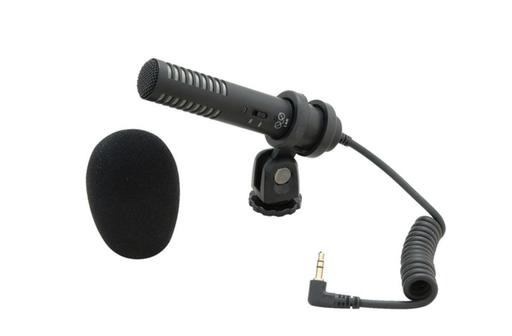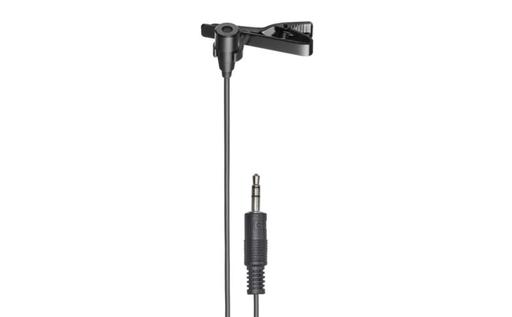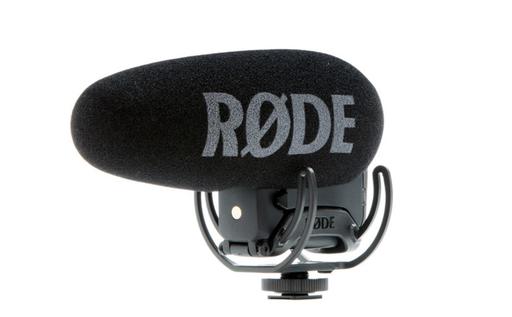There are certain features that I absolutely have to have in an everyday camera that's going to meet my photography and video needs. One of those requirements is a port to connect an external mic. Microphones are to audio what lenses are to photography. And you need to have your options available.
I use three different types of microphones for video work: general purpose condenser, lavalier, and shotgun. Like lenses, each has its own characteristics and excels in specific situations.
Condenser Mic
 Audio-Technica Pro-24CM - Compact Stereo Condenser Mic for recording ambient sound and voice.
Audio-Technica Pro-24CM - Compact Stereo Condenser Mic for recording ambient sound and voice.
I use a condenser for general purpose work. Currently, I keep a Audio-Technica Pro-24CM compact stereo condenser ($99) in my backpack for capturing ambient sounds, music, and voice. This is not a device that I would mount on the camera for interviews. It works great when the mic is close to the mouth, but not from a distance.
When used properly, the audio quality is quite good. You can hear for yourself via an unedited sound check with the Pro-24 plugged into a Fujifilm X100V using an 3.5mm mini female to 2.5mm sub-mini male adapter. Here is a 4K video with audio sound check recorded with this gear. Footage is right out of the camera. No editing. The audio is quite decent. Note: My mic is an older model that shipped with a long cord. You may need an extender cable depending on what you have planned.
Pro Tip: When working with wired mics, wear dark clothing to make the line less visible. Check out the video to see how effective this can be.
Lavalier Mic
 Audio-Technica Consumer ATR3350XiS Omnidirectional Condenser Lavalier Mic for recording voice in noisy environments and when I need my hands free.
Audio-Technica Consumer ATR3350XiS Omnidirectional Condenser Lavalier Mic for recording voice in noisy environments and when I need my hands free.
Lavalier mics are very handy when you need to talk in noisy environments. Just clip one to your shirt and go. Professional videographers typically use wireless models. These can get quite expensive, and there are more technical variables to deal with. I use a wired model for my more infrequent use. The cord is quite long, and I can usually tuck it out of the way so it isn't a distraction.
If you're using lavs for interviews, you'll need two. And you'll need to devise a system to run them both through the camera. One trick that is use for interviews is for me to stand off-camera with the handheld condenser mic and have the interviewee on-camera with the lav. This works well and is easy to setup.
Pro Tip: Run the wire from the lavalier inside the shirt and out the side or back obscured from view. Doing so will draw less attention to the mic itself.
Shotgun Mic
 Rode VideoMic Pro+ Camera-Mount Shotgun Mic for interviews and general recording when the mic needs to remain on the camera.
Rode VideoMic Pro+ Camera-Mount Shotgun Mic for interviews and general recording when the mic needs to remain on the camera.
For me, shotgun mics are the most difficult to work with, but when you need one, you need one. They are particularly handy in "run 'n gun" situations when you might be talking to one person one moment, and another the next. For example, if I were recording candid interviews during a wedding reception, I would use the shotgun mounted on the camera.
They are called shotguns because they have a tighter pattern of sensitivity compared to omni-directional mics. So, wherever you point the shotgun, that will be its sweet spot for capture. And that's why they work so well atop cameras above the lens.
Under ideal circumstances, they can sound quite good. But videographers tend to push the envelope with them, and the audio quality can suffer a bit. I would recommend testing the mic in a comparable environment before use. Experiment with gain settings and distance to subject. Once you have a feel for the mic's sweet spot, you can attempt to stay within those parameters during the live shoot.
Pro Tip - A good accessory for shotguns is a fur windshield that allows you to capture cleaner audio in breezy conditions. Mics are very sensitive to air movement (right?), and one of these can really save the day for outdoor events.
Final Thoughts
All of these mic options are superior to using the onboard pickups in your camera. With an external mic, you're free to make camera adjustments without those sounds being recorded, and you can choose the best type of mic for the job at hand.
Product Links and Comments
There are product links in this article that contain affiliate tags. In some cases, depending on the product, The Digital Story may receive compensation if you purchase a product via one of those links. There is no additional cost to you.
You can share your thoughts at the TDS Facebook page, where I'll post this story for discussion.











